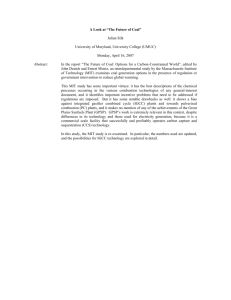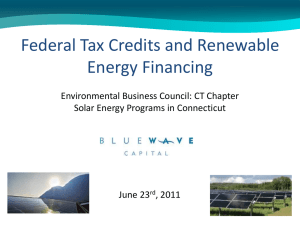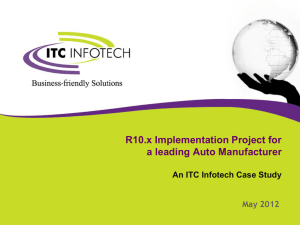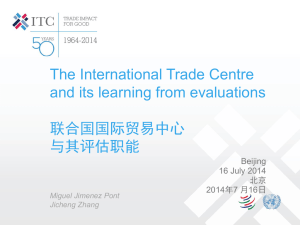30_Financing_Assumptions_v
advertisement
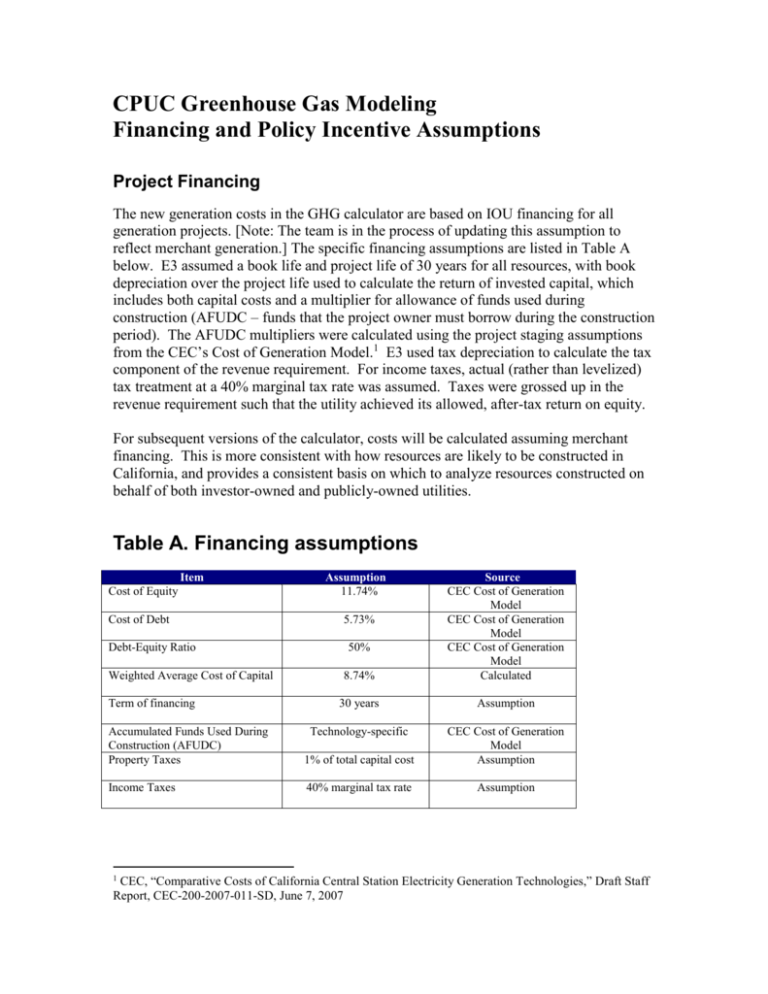
CPUC Greenhouse Gas Modeling Financing and Policy Incentive Assumptions Project Financing The new generation costs in the GHG calculator are based on IOU financing for all generation projects. [Note: The team is in the process of updating this assumption to reflect merchant generation.] The specific financing assumptions are listed in Table A below. E3 assumed a book life and project life of 30 years for all resources, with book depreciation over the project life used to calculate the return of invested capital, which includes both capital costs and a multiplier for allowance of funds used during construction (AFUDC – funds that the project owner must borrow during the construction period). The AFUDC multipliers were calculated using the project staging assumptions from the CEC’s Cost of Generation Model.1 E3 used tax depreciation to calculate the tax component of the revenue requirement. For income taxes, actual (rather than levelized) tax treatment at a 40% marginal tax rate was assumed. Taxes were grossed up in the revenue requirement such that the utility achieved its allowed, after-tax return on equity. For subsequent versions of the calculator, costs will be calculated assuming merchant financing. This is more consistent with how resources are likely to be constructed in California, and provides a consistent basis on which to analyze resources constructed on behalf of both investor-owned and publicly-owned utilities. Table A. Financing assumptions Item Cost of Equity Cost of Debt Debt-Equity Ratio Weighted Average Cost of Capital Term of financing Assumption 11.74% 8.74% Source CEC Cost of Generation Model CEC Cost of Generation Model CEC Cost of Generation Model Calculated 30 years Assumption Technology-specific 5.73% 50% Accumulated Funds Used During Construction (AFUDC) Property Taxes 1% of total capital cost CEC Cost of Generation Model Assumption Income Taxes 40% marginal tax rate Assumption CEC, “Comparative Costs of California Central Station Electricity Generation Technologies,” Draft Staff Report, CEC-200-2007-011-SD, June 7, 2007 1 Capital Cost Multipliers E3 applied a set of multipliers to capital costs in each region to reflect regional differences in land, labor and construction costs. The multipliers were obtained from the U.S. Army Corps of Engineers, Civil Works Construction Cost Index System (March 31, 2007). The multipliers are listed in Table B below. Table B. Regional Capital Cost Multipliers Resource Zone Name Alberta Arizona-Southern Nevada British Columbia California Colorado Montana New Mexico Northern Nevada Northwest Utah-Southern Idaho Wyoming Capital Cost Factor 1.00 1.00 1.00 1.20 0.97 1.02 0.96 1.09 1.11 1.00 0.92 Tax and Policy Incentives Many of the generating technologies in the GHG calculator are eligible for a variety of tax breaks and other incentives from either the federal or state governments. None of these incentives have been included in the current round of results. This assumption is under review for the next round of results. Table C. Policy Incentive assumptions Technology Coal IGCC Coal IGCC w/ CCS Coal ST Incentives Federal 20% ITC (limited to first 4 GW of new None. IGCC capacity);1 Loan guarantees of up to 80% for qualifying technologies. 2 20% ITC (limited to first 4 GW of new None. IGCC capacity); 1 Loan guarantees of up to 80%.2 If advanced coal technology: 15% ITC None. (limited to first 3 GW of new capacity); 1 CA State Incentives Technology Natural Gas CCCT None. None. Natural Gas CT None. None. Nuclear 1.8¢/kWh PTC (nominal $) for first 8 years of operation if in-service by 2020 (limited to first 6 GW of new capacity); 3 Loan guarantees of up to 80%.2 If closed loop biomass: 1.9¢/kWh PTC (inflation-adjusted 2007$) for first 10 years of if in service by 2008, If landfill gas, municipal solid waste or open loop biomass: 1.0¢/kWh PTC for first 10 years of if in service by 2008. 4 None. Geothermal 1.9¢/kWh PTC (inflation-adjusted 2007$) for first 10 years of operation if in-service by 20084 OR 10% permanent ITC5; Accelerated depreciation (5 year)6 SEP eligible7 Large Hydro For incremental addition at existing generator, or generation built at existing non-hydroelectric dam: 1.0¢/kWh PTC (inflation-adjusted 2007$) for first 10 years if in-service by 20084 None. Small Hydro 1.0¢/kWh PTC (inflation-adjusted 2007$) for first 10 years if in-service by 20084 SEP eligible if ≤30 MW and no increased water diversion7 Solar Thermal 30% ITC if in-service by 2008, 10% permanent ITC otherwise5; accelerated depreciation (5 year)6 100% property tax exemption8; SEP eligible7 Biogas & Biomass Federal CA State SEP eligible (if meets certain requirements)7 1.9¢/kWh PTC (inflation-adjusted 2007$) SEP eligible7 for first 10 years of operation if in-service by 20084; Accelerated depreciation (5 year)6 PTC= Production Tax Credit; ITC = Investment Tax Credit; SGIP = Self Generation Incentive Program; RPS = Renewable Portfolio Standard MSW = Municipal Solid Waste SEP = Supplemental Energy Payments Wind Sources and Footnotes Federal Policy Incentives: 1 Investment Tax Credit (ITC) for IGCC and Advanced Coal Technologies: From the Energy Policy Act of 2005, Title XIII, Section 48A (Qualifying Advanced Coal Project Credit), and Section 48B (Qualifying Gassification Project Credit). ITC is limited to a national total of 4.125 GW for new IGCC capacity and to 3.375 GW for other advanced coal-based generation technologies. Funding is also limited to a total of $800 million in total ITCs for gasification, and $500 million in total ITCs for advanced coal technologies. Technologies to retrofit or re-power existing coal plants may also qualify as an advanced coal technology, provided that the fuel input is at least 75% coal. To be designated as an advanced coal project, new non-IGCC plants must have: (a) heat rate of 8530 Btu/kWh or better [subject to some adjustments] (b) SO2 removal of 99% or higher, (c) NOx Emissions of 0.07 lbs/MMBTU, (d) Particulate emission of 0.015 lbs/MMBTU, and (d) Mercury removal of 90% or higher. IGCC technologies used for generators using petroleum residue or biomass may also qualify for the gasification ITC. Application must be submitted to DOE by 2006 and online date must be within 7 years; ITC value is reduced proportionally for plants also receiving incentive loan guarantees. 2 Federal Loan Guarantees for Innovative Technologies: Coal facilities with IGCC or carbon sequestration, and certain advanced nuclear technologies may qualify for federal loan guarantees of no more than 80% of project cost under then Energy Policy Act of 2005, Title XVII, Section 1702-1704. IGCC plants must meet certain performance and emissions requirements to qualify, and have one of a number of defined innovative components, including a CO2-capture ready design. 3 Production Tax Credit (PTC) for Nuclear: From the Energy Policy Act of 2005, Title XIII, Section 45J (Credit for Production from Advanced Nuclear Facilities). “Advanced Nuclear” is deemed to be any nuclear reactor design approved by the Nuclear Regulatory Commission after 1993. The credit is limited to the first 6 GW of new nuclear capacity in the U.S., and is limited to $125 million per GW annually. If more than 6 GW are under construction before January 1, 2014, the production will be shared among the new reactors on a proportional basis (e.g., if 9 GW of new capacity are under construction by that date, the PTC will be set to 1.2¢/kWh (= 1.8¢/kWh * 6 GW / 9 GW). [Allocation described in EIA, “Assumptions to Annual Energy Outlook 2007”, p. 88.]. 4 Investment Tax Credit (ITC) for Solar, Geothermal: Also known as the business energy tax credit, from United States Code (USC) Title 26 (Internal Revenue Code), § 48. Expanded by the Energy Policy Act of 2005, House Resolution (H.R.) 6, and extended to cover all installations before January 1, 2009 by the Tax Relief and Healthcare Act of 2006 (H.R. 6111), Section 207. Energy Policy Act of 1992 created a permanent 10% ITC for solar, geothermal, and qualifying biomass generation. Energy Policy Act of 2005 temporarily raised this ITC to 30% for solar technologies installed between 2006 and 2008. Credit is reduced if generation is subsidized by other state or federal level financing incentives. 5 Production Tax Credit (PTC) for Qualifying Biomass, Geothermal, Wind, and Hydro: Officially the Renewable Electricity Production Credit (REPC), from United States Code (USC) Title 26 (Internal Revenue Code), § 45. Originally enacted as part Energy Policy Act of 1992 to apply to installations of wind and qualifying biomass during or before 2001. Renewed for 2006-2007 under the Energy Policy Act of 2007, and extended to geothermal and qualifying hydro generation as well. Extended through end of 2008 under the the Tax Relief and Health Care Act of 2006 (H.R. 6111). “Closed-loop biomass” is defined as “any organic material from a plant which is planted exclusively for purposes of being used at a qualified facility to produce electricity.” If the reference energy price exceeds 8 cents/kWh in the year, the PTC is reduced proportionally to as low as 3 cents/kWh. 6 Accelerated Depreciation: USC, Chapter 26, § 168 (2005). Under the Modified Accelerated Cost-Recovery System (MACRS), business can recover their investments more quickly through accelerated depreciation on solar, geothermal, wind and photovoltaic generation assets, reducing their corporate income tax. These renewable technologies are classified as “5-year property”. For more information, see IRS Publication 946, IRS Form 4562: Depreciation and Amortization, and Instructions for Form 4562. California Policy Incentives: 7 Supplemental Energy Payments (SEP): Facilities must be are new or repowered on or after January 1, 2002, and may receive payments for up to 10 years. RPS eligible generators that win contracts with IOUs in California can apply to the CEC to receive SEPs to cover the difference between the MPR (market price referent) and the accepted bid price, subject to funding availability. 8 CA Property Tax Exemption for Solar Systems: From CA Revenue & Tax Code § 73. AB1099 in 2005 extended this section to apply to all systems installed before January 1, 2009. Further description of Federal and state policy incentives: North Carolina Solar Center & Interstate Renewable Energy Council, Database of State Incentives for Renewables & Efficiency (February 2007 Update). http://www.dsireusa.org/Index.cfm?EE=0&RE=1 U.S. Energy Information Administration, “Assumptions to the Annual Energy Outlook 2007,” Report # DOE/EIA-0554(2007), http://www.eia.doe.gov/oiaf/aeo/assumption/index.html.

